Effects of Land Use Changes on Ecosystem Service Value in Xiangjiang River Basin, China
Abstract
1. Introduction
2. Materials and Methods
2.1. Study Area
2.2. Data Sources
2.3. Research Methods
2.3.1. Change Component Analysis
2.3.2. Intensity Analysis
2.3.3. Estimating the Value of Ecosystem Services
2.3.4. Cross Sensitivity Coefficient
3. Results
3.1. Analysis of the Components of Land
3.1.1. Analysis of Total Land Use Component Change
3.1.2. Analysis of the Change Components of Different Categories
3.2. Intensity Analysis of LULC
3.2.1. Interval Level
3.2.2. Category Level
3.2.3. Transition Level
3.3. Analysis of Ecosystem Service Value
3.3.1. Temporal Changes in Ecosystem Service Values
3.3.2. Spatiotemporal Change of Ecosystem Service Value
3.4. Impacts of Land Use on Ecosystem Service Values
4. Discussion
4.1. Pattern and Process of LULC
4.2. The Relationship between LULC and ESV
5. Conclusions
- (1)
- Over the past four decades, land use in the Xiangjiang River Basin has undergone dramatic changes, the intensity of which has shown a continuous increase, mainly in the form of quantity changes and shift changes. The increase in built-up land and bare land and the decrease in cultivated land are stable and active, and the loss of forest land is large.
- (2)
- In the past 40 years, the ESV of the Xiangjiang River Basin has significantly changed in time, first increasing and then decreasing, and the spatial changes are most obvious in the middle and southeast of the basin.
- (3)
- The value provided by land use types was in the order of forest land > cultivated land > water area > grassland > unused land, and the cross-sensitivity coefficient reflected that the net conversion between cultivated land and forest land and water area had a promoting effect on ESV.
Author Contributions
Funding
Acknowledgments
Conflicts of Interest
References
- Costanza, R. Valuing natural capital and ecosystem services toward the goals of efficiency, fairness, and sustainability. Ecosyst. Serv. 2020, 43, 101096. [Google Scholar] [CrossRef]
- Fu, Q.; Li, B.; Hou, Y.; Bi, X.; Zhang, X. Effects of land use and climate change on ecosystem services in Central Asia’s arid regions: A case study in Altay Prefecture, China. Sci. Total Environ. 2017, 607, 633–646. [Google Scholar] [CrossRef]
- Millennium Ecosystem Assessment. Ecosystems and human well-being: Synthesis. Physics Teacher. 2005, 34, 534. [Google Scholar]
- Felipe-Lucia, M.R.; Soliveres, S.; Penone, C.; Fischer, M.; Ammer, C.; Boch, S.; Allan, E. Land-use intensity alters networks between biodiversity, ecosystem functions, and services. Proc. Natl. Acad. Sci. USA 2020, 117, 28140–28149. [Google Scholar] [CrossRef]
- Deng, G.; Tang, Z.; Hu, G.; Wang, J.; Sang, G.; Li, J. Spatiotemporal dynamics of snowline altitude and their responses to climate change in the Tienshan Mountains, Central Asia, During 2001–2019. Sustainability 2021, 13, 3992. [Google Scholar] [CrossRef]
- Tang, Z.; Ma, J.; Peng, H.; Wang, S.; Wei, J. Spatiotemporal changes of vegetation and their responses to temperature and precipitation in upper Shiyang river basin. Adv. Space Res. 2017, 60, 969–979. [Google Scholar] [CrossRef]
- Schneider, A.; Logan, K.E.; Kucharik, C.J. Impacts of urbanization on ecosystem goods and services in the US Corn Belt. Ecosystems 2012, 15, 519–541. [Google Scholar] [CrossRef]
- Bai, Y.; Chen, Y.; Alatalo, J.M.; Yang, Z.; Jiang, B. Scale effects on the relationships between land characteristics and ecosystem services—A case study in Taihu Lake Basin, China. Sci. Total Environ. 2020, 716, 137083. [Google Scholar] [CrossRef]
- Benton, T.G.; Bailey, R.; Froggatt, A.; King, R.; Lee, B.; Wellesley, L. Designing sustainable land use in a 1.5 C world: The complexities of projecting multiple ecosystem services from land. Curr. Opin. Environ. Sustain. 2018, 31, 88–95. [Google Scholar] [CrossRef]
- Vitousek, P.M.; Mooney, H.A.; Lubchenco, J.; Melillo, J.M. Human domination of Earth’s ecosystems. Science 1997, 277, 494–499. [Google Scholar] [CrossRef]
- Chen, W.U.; Li, J.F.; Zeng, J.; Ran, D.; Yang, B. Spatial differentiation and formation mechanism of ecological and environmental effects of land use change in China. Geogr. Res. 2019, 9, 2173–2187. [Google Scholar]
- Wang, J.; Zhou, W.; Pickett, S.T.; Yu, W.; Li, W. A multiscale analysis of urbanization effects on ecosystem services supply in an urban megaregion. Sci. Total Environ. 2019, 662, 824–833. [Google Scholar] [CrossRef]
- SCEP. Man’s Impact on the Global Environment; MIT Press: Cambridge, UK, 1970. [Google Scholar]
- Daliy, G.C. Nature’s Services: Societal Dependence on Natural Ecosystems. Pac. Conserv. Biol. 1997, 6, 220–221. [Google Scholar]
- Costanza, R.; d’Arge, R.; deGroot, R.; Farber, S.; Grasso, M.; Hannon, B.; Limburg, K.; Naeem, S.V.; O’Neill, R.; Paruelo, J.G.; et al. The value of the world’s ecosystem services and natural capital. Nature 1997, 387, 253–260. [Google Scholar] [CrossRef]
- Estoque, R.C.; Murayama, Y. Examining the potential impact of land use/cover changes on the ecosystem services of Baguio city, the Philippines: A scenario-based analysis. Appl. Geogr. 2012, 35, 316–326. [Google Scholar] [CrossRef]
- Wang, Z.; Cao, J.; Zhu, C.; Yang, H. The impact of land use change on ecosystem service value in the upstream of Xiong’an new area. Sustainability 2020, 12, 5707. [Google Scholar] [CrossRef]
- Xiao, Y.; Huang, M.; Xie, G.; Zhen, L. Evaluating the impacts of land use change on ecosystem service values under multiple scenarios in the Hunshandake region of China. Sci. Total Environ. 2022, 850, 158067. [Google Scholar] [CrossRef]
- Xie, G.; Zheng, L.; Lu, C.; Xiao, Y.; Chen, C. Expert Knowledge Based Valuation Method of Ecosystem Services in China. J. Nat. Resour. 2008, 5, 911–919. [Google Scholar]
- Xie, G.; Zhang, C.; Zhang, L.; Chen, W.; Li, S. Improvement of ecosystem service value method based on unit area value equivalent factor. J. Nat. Resour. 2015, 30, 1243–1254. [Google Scholar]
- Xue, M.; Ma, S. Optimized Land-Use Scheme Based on Ecosystem Service Value: Case Study of Taiyuan, China. J. Urban Plan. Dev. 2018, 144, 04018016. [Google Scholar] [CrossRef]
- Ye, Y.; Bryan, B.A.; Zhang, J.; Connor, J.D.; Chen, L.; Qin, Z.; He, M. Changes in land-use and ecosystem services in the Guangzhou-Foshan Metropolitan Area, China from 1990 to 2010: Implications for sustainability under rapid urbanization. Ecol. Indic. 2018, 93, 930–941. [Google Scholar] [CrossRef]
- Yi, L.; Zhang, Z.; Zhao, X.; Liu, B.; Wang, X.; Wen, Q.; Zuo, L.; Liu, F.; Xu, J.; Hu, S. Have Changes to Unused Land in China Improved or Exacerbated Its Environmental Quality in the Past Three Decades? Sustainability 2016, 8, 184. [Google Scholar] [CrossRef]
- Wang, Y.; Gao, J.; Wang, J.; Qiu, J. Value assessment of ecosystem services in nature reserves in Ningxia, China: A response to ecological restoration. PLoS ONE 2014, 9, e89174. [Google Scholar] [CrossRef]
- Yuan, K.; Li, F.; Yang, H.; Wang, Y. The Influence of Land Use Change on Ecosystem Service Value in Shangzhou District. Int. J. Environ. Res. Public Health 2019, 16, 1321. [Google Scholar] [CrossRef]
- Wei, Y.D.; Ye, X. Urbanization, urban land expansion and environmental change in China. Stoch. Environ. Res. Risk Assess 2014, 28, 757–765. [Google Scholar] [CrossRef]
- Wu, C.; Ma, G.; Yang, W.; Zhou, Y.; Peng, F.; Wang, J. Assessment of ecosystem service value and its differences in the Yellow River Basin and Yangtze River Basin. Sustainability 2021, 13, 3822. [Google Scholar] [CrossRef]
- Zhou, Y.; Li, J.; Pu, L. Quantifying ecosystem service mismatches for land use planning: Spatial-temporal characteristics and novel approach—A case study in Jiangsu Province, China. Environ. Sci. Pollut. Res. 2022, 29, 26483–26497. [Google Scholar] [CrossRef]
- Cheng, X.; Han, H. Analyzing land-use change scenarios for ecosystem services and their trade-offs in the ecological conservation area in Beijing, China. Int. J. Environ. Res. Public Health 2020, 17, 8632. [Google Scholar]
- Li, J.; Qin, J.; Wang, K.; Liang, C.; Yuan, H. Response of environmental system change to hydrological regime in Dongting Lake. Acta Geogr. Sin. 2004, 2, 239–248. [Google Scholar]
- Xiong, Y.; Wang, K.; Lv, H. Preliminary study on agricultural ecological security and sustainable development in Hunan Province. Resour. Environ. Yangtze Basin 2003, 5, 433–439. [Google Scholar]
- Quan, B.; Ren, H.; Pontius, R.G., Jr.; Liu, P. Quantifying Spatiotemporal Patterns Concerning Land Change in Changsha, China. Landsc. Ecol. Eng. 2018, 14, 257–267. [Google Scholar] [CrossRef]
- Pontius, R.G., Jr.; Santacruz, A. Quantity, exchange, and shift components of difference in a square contingency table. Int. J. Remote Sens. 2014, 35, 7543–7554. [Google Scholar] [CrossRef]
- Pontius, R.G., Jr. Component intensities to relate difference by category with difference overall. Int. J. Appl. Earth Obs. 2019, 77, 94–99. [Google Scholar] [CrossRef]
- Fan, X.; Quan, B.; Deng, Z.; Liu, J. Study on Land Use Changes in Changsha–Zhuzhou–Xiangtan under the Background of Cultivated Land Protection Policy. Sustainability 2022, 14, 15162. [Google Scholar] [CrossRef]
- Aldwaik, S.Z.; Pontius, R.G., Jr. Intensity Analysis to unify measurements of size and stationarity of land changes by interval, category, and transition. Landsc. Urban Plan 2012, 106, 103–114. [Google Scholar] [CrossRef]
- Quan, B.; Fan, X.J.; Liu, P.L.; Guo, T.; Hu, Z.; Du, G.Q.; Sun, S.; Deng, Z.W.; Wang, Z.S. ArcGIS 10.8 Geographical Information System Software and Application; China Environment Publishing Group: Beijing, China, 2021; pp. 158–163. [Google Scholar]
- Shoyama, K.; Braimoh, A.K. Analyzing about sixty years of land-cover change and associated landscape fragmentation in Shiretoko Peninsula, northern Japan. Landsc. Urban Plan 2011, 101, 22–29. [Google Scholar] [CrossRef]
- Kourosh Niya, A.; Huang, J.; Karimi, H.; Keshtkar, H.; Naimi, B. Use of intensity analysis to characterize land use/cover change in the biggest Island of Persian Gulf, Qeshm Island, Iran. Sustainability 2019, 11, 4396. [Google Scholar] [CrossRef]
- Deng, Z.; Quan, B. Intensity Characteristics and Multi-Scenario Projection of Land Use and Land Cover Change in Hengyang, China. Int. J. Environ. Res. Public Health 2022, 19, 8491. [Google Scholar] [CrossRef]
- Xie, Z.; Pontius, R.G., Jr.; Huang, J.; Nitivattananon, V. Enhanced Intensity Analysis to quantify categorical change and to identify suspicious land transitions: A case study of Nanchang, China. Remote Sens. 2020, 12, 3323. [Google Scholar] [CrossRef]
- Deng, Z.; Quan, B.; Qi, J.; Peng, K.; Fan, X. Intensity Analysis and Driving Forces of Pattern Evolution in Productive-Living-Ecological Land: A Case Study of Hengyang City. Chin. J. Soil. Sci. 2022, 6, 1–13. [Google Scholar] [CrossRef]
- Nyamekye, C.; Kwofie, S.; Ghansah, B.; Agyapong, E.; Boamah, L.A. Assessing urban growth in Ghana using machine learning and Intensity Analysis: A case study of the New Juaben Municipality. Land Use Policy 2020, 99, 105057. [Google Scholar] [CrossRef]
- Meng, X.; Gao, X.; Li, S.; Li, S.; Lei, J. Monitoring desertifification in Mongolia based on Landsat images and Google Earth Engine from 1990 to 2020. Ecol. Indic. 2021, 129, 107908. [Google Scholar] [CrossRef]
- Sun, X.; Li, G.; Wang, J.; Wang, M. Quantifying the Land Use and Land Cover Changes in the Yellow River Basin while Accounting for Data Errors Based on GlobeLand30 Maps. Land 2021, 10, 31. [Google Scholar] [CrossRef]
- Quan, B.; Pontius, R.G., Jr.; Song, H. Intensity Analysis to communicate land change during three time intervals in two regions of Quanzhou City, China. GI Sci. Remote Sens. 2020, 57, 21–36. [Google Scholar] [CrossRef]
- Han, Y.; Zheng, W.; Deng, W. GIS-based analysis of spatial and temporal changes in ecosystem service values and their drivers in the Xiangjiang River Basin. Land Nat. Resour. Res. 2021, 51–57. [Google Scholar] [CrossRef]
- Chen, X.; Wang, K.; Qi, X.; Li, H. Landscape pattern change and response of ecological service value in Xiangjiang River Basin. Econ. Geogr. 2016, 5, 175–181. [Google Scholar]
- Wang, Z.; XU, J. The impact of land use evolution on the value of ecosystem services in national parks: A case study of Sanjiangyuan National Park. Acta Ecol. Sin. 2022, 42, 6948–6958. [Google Scholar]
- Crouzat, E.; Mouchet, M.; Turkelboom, F.; Byczek, C.; Meersmans, J.; Berger, F.; Lavorel, S. Assessing bundles of ecosystem services from regional to landscape scale: Insights from the French Alps. J. Appl. Ecol. 2015, 52, 1145–1155. [Google Scholar] [CrossRef]
- Turner, K.G.; Odgaard, M.V.; Bøcher, P.K.; Dalgaard, T.; Svenning, J.C. Bundling ecosystem services in Denmark: Trade-offs and synergies in a cultural landscape. Landsc. Urban Plan 2014, 125, 89–104. [Google Scholar] [CrossRef]
- De Alban, J.D.T.; Prescott, G.W.; Woods, K.M.; Jamaludin, J.; Latt, K.T.; Lim, C.L.; Webb, E.L. Integrating analytical frameworks to investigate land-cover regime shifts in dynamic landscapes. Sustainability 2019, 11, 1139. [Google Scholar] [CrossRef]
- Barnieh, B.A.; Jia, L.; Menenti, M.; Jiang, M.; Zhou, J.; Lv, Y.; Bennour, A. Quantifying spatial reallocation of land use/land cover categories in West Africa. Ecol. Indic. 2022, 135, 108556. [Google Scholar] [CrossRef]
- Zhou, Z.; Huang, J.; Zhou, P. Land use system transfer analysis method and its application. J. Subtrop. Resour. Environ. 2012, 4, 28–38. [Google Scholar]
- Li, T.; Chen, J.; Feng, Q.; Wang, K.; Liao, J. Land use/cover change and its influencing factors in Xiangjiang River Basin, Hunan Province from 1990 to 2010. Hunan J. Ecol. Sci. 2016, 4, 10–17. [Google Scholar]
- Zhu, X.; Yao, D.; Shi, H.; Qu, K.; Tang, Y.; Zhao, K. The Evolution Mode and Driving Mechanisms of the Relationship 586 between Construction Land Use and Permanent Population in Urban and Rural Contexts: Evidence from China’s Land Survey. Land 2022, 11, 1721. [Google Scholar] [CrossRef]
- Zhong, X.; Guo, C.; Zhi, Z.; Zhi, S.; Loomis, J. Applying contingent valuation in China to measure the total economic value of restoring ecosystem services in Ejina region. Ecol. Econ. 2003, 44, 345–358. [Google Scholar] [CrossRef]
- Finlayson, M.; Cruz, R.D.; Davidson, N.; Alder, J.; Cork, S.; De Groot, R.S.; Taylor, D. Millennium Ecosystem Assessment: Ecosystems and Human Well-Being: Wetlands and Water Synthesis; Island Press: Washington, DC, USA, 2005. [Google Scholar]
- Zhao, Q.; Wen, Z.; Chen, S.; Ding, S.; Zhang, M. Quantifying land use/land cover and landscape pattern changes and impacts on ecosystem services. Int. J. Environ. Res. Public Health 2020, 17, 126. [Google Scholar] [CrossRef]
- Huang, B.; Huang, J.; Pontius, R.G., Jr.; Tu, Z. Comparison of Intensity Analysis and the land use dynamic degrees to measure land changes outside versus inside the coastal zone of Longhai, China. Ecol. Indic. 2018, 89, 336–347. [Google Scholar] [CrossRef]
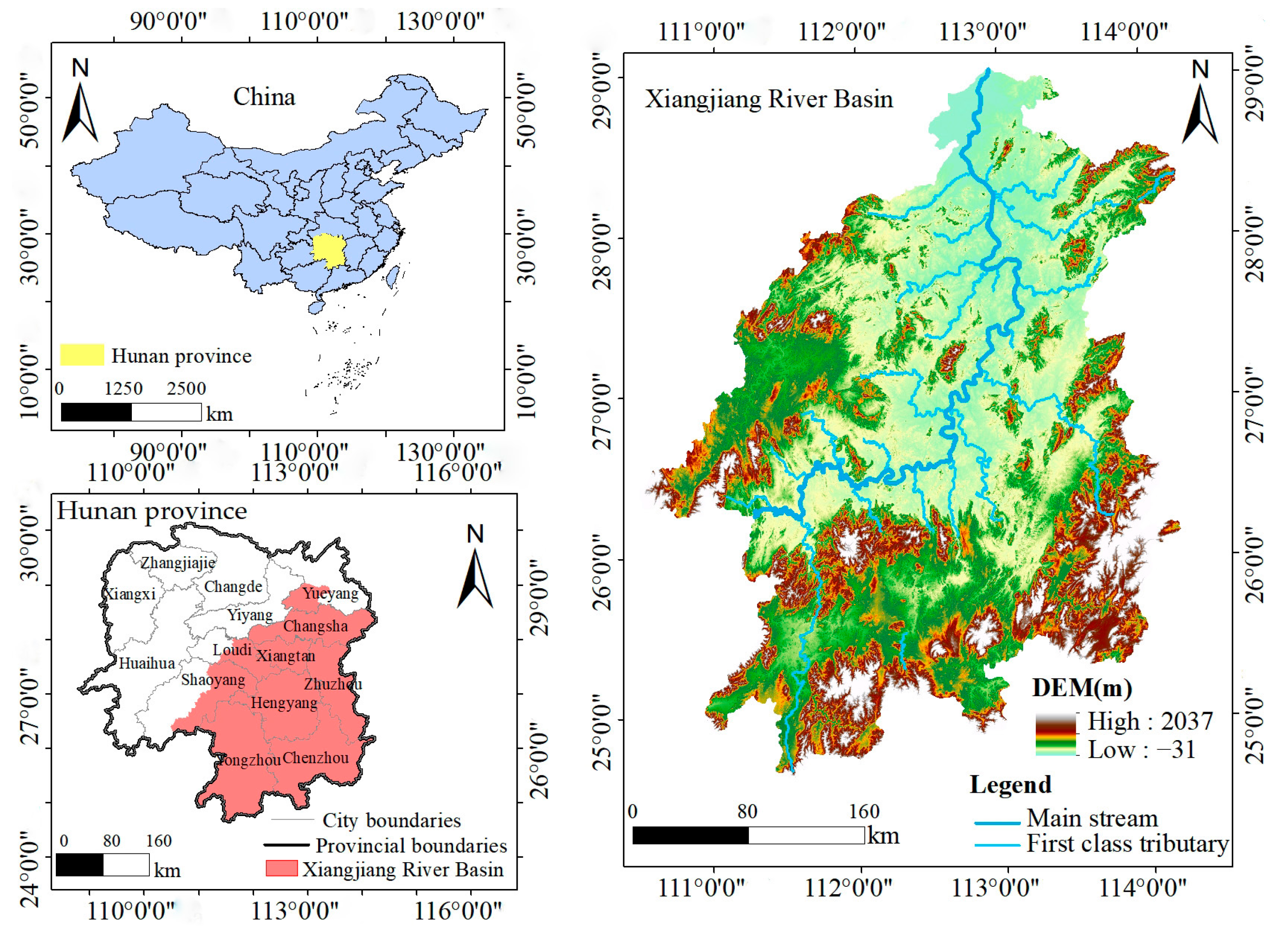
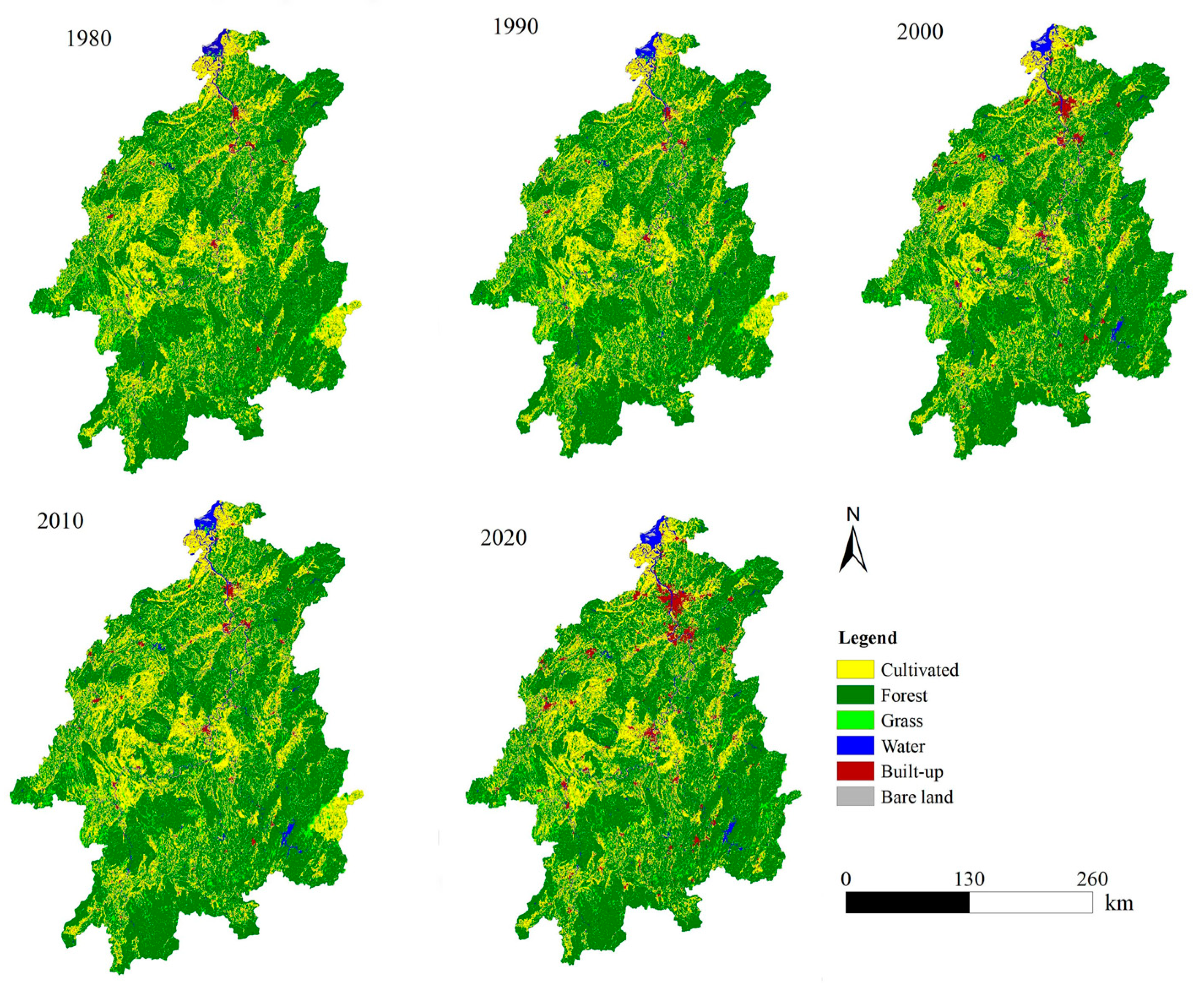

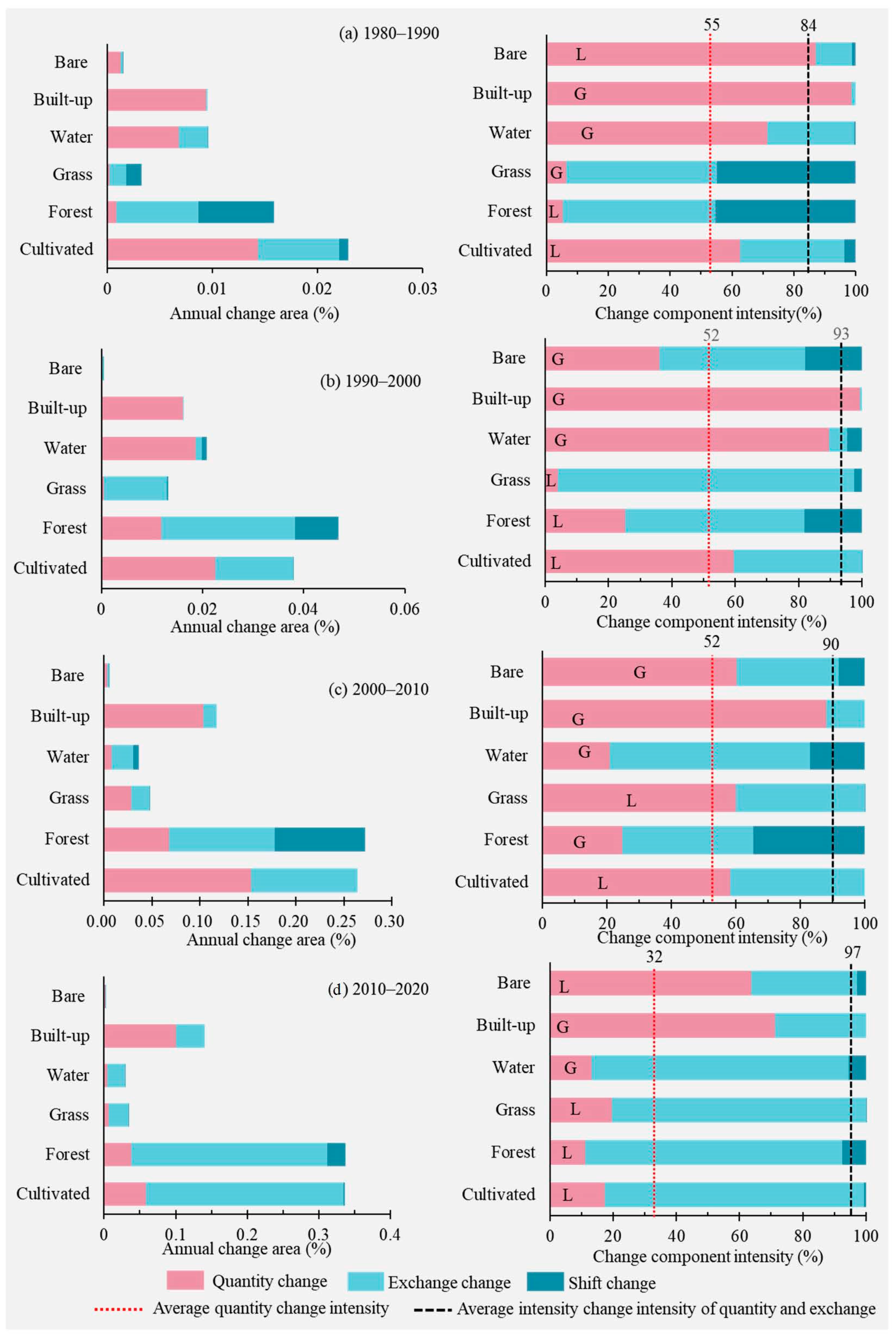
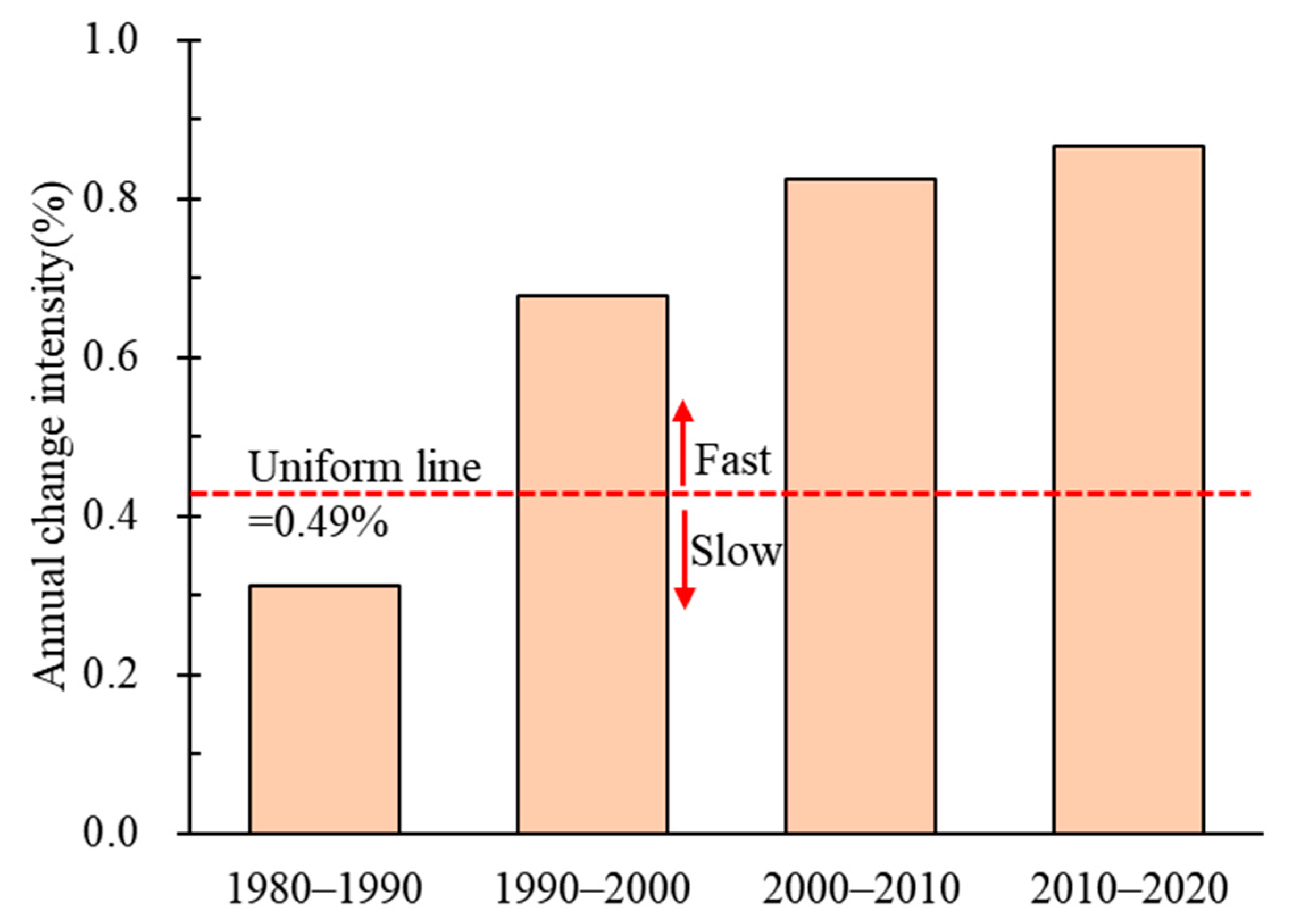
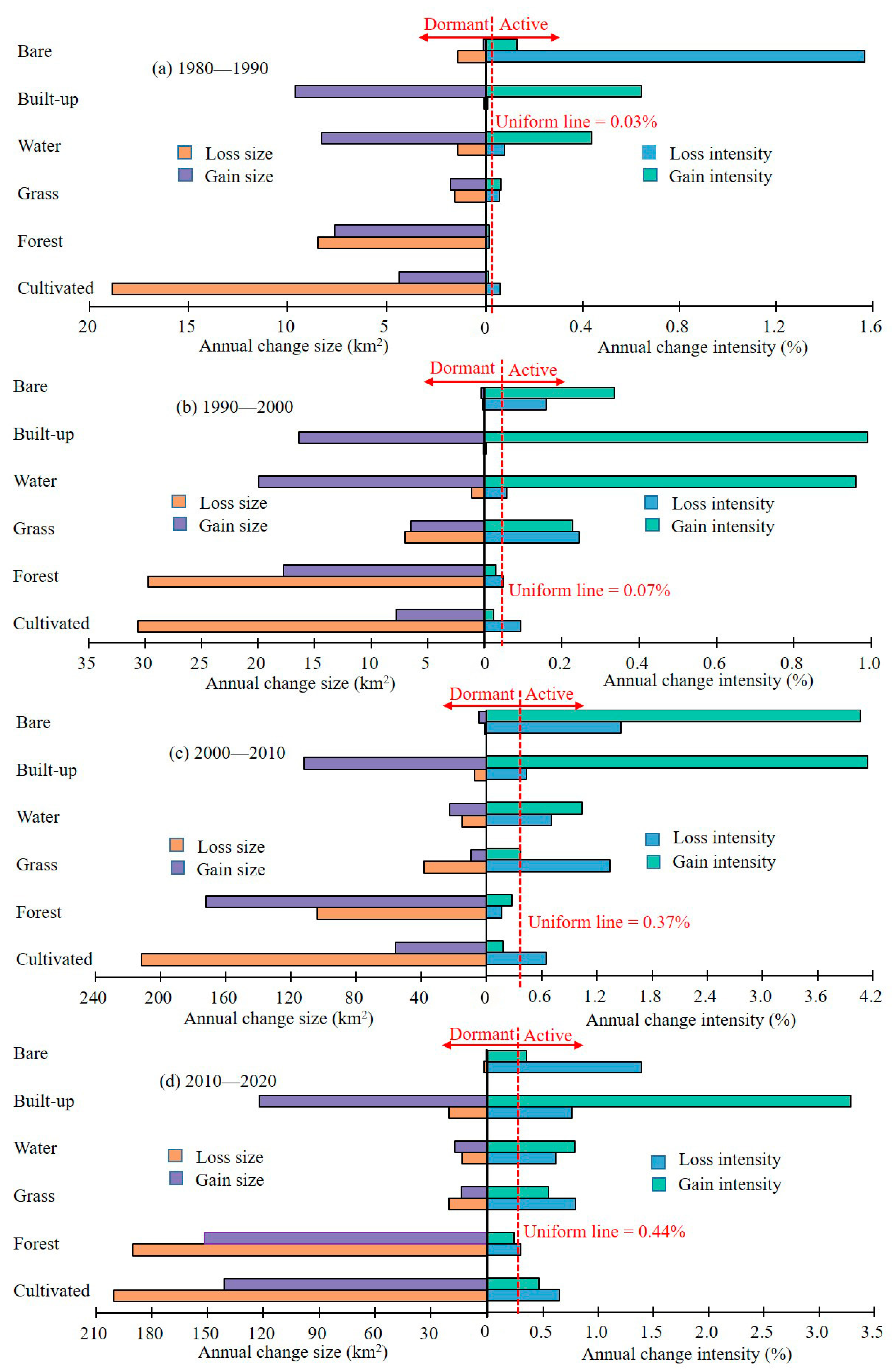
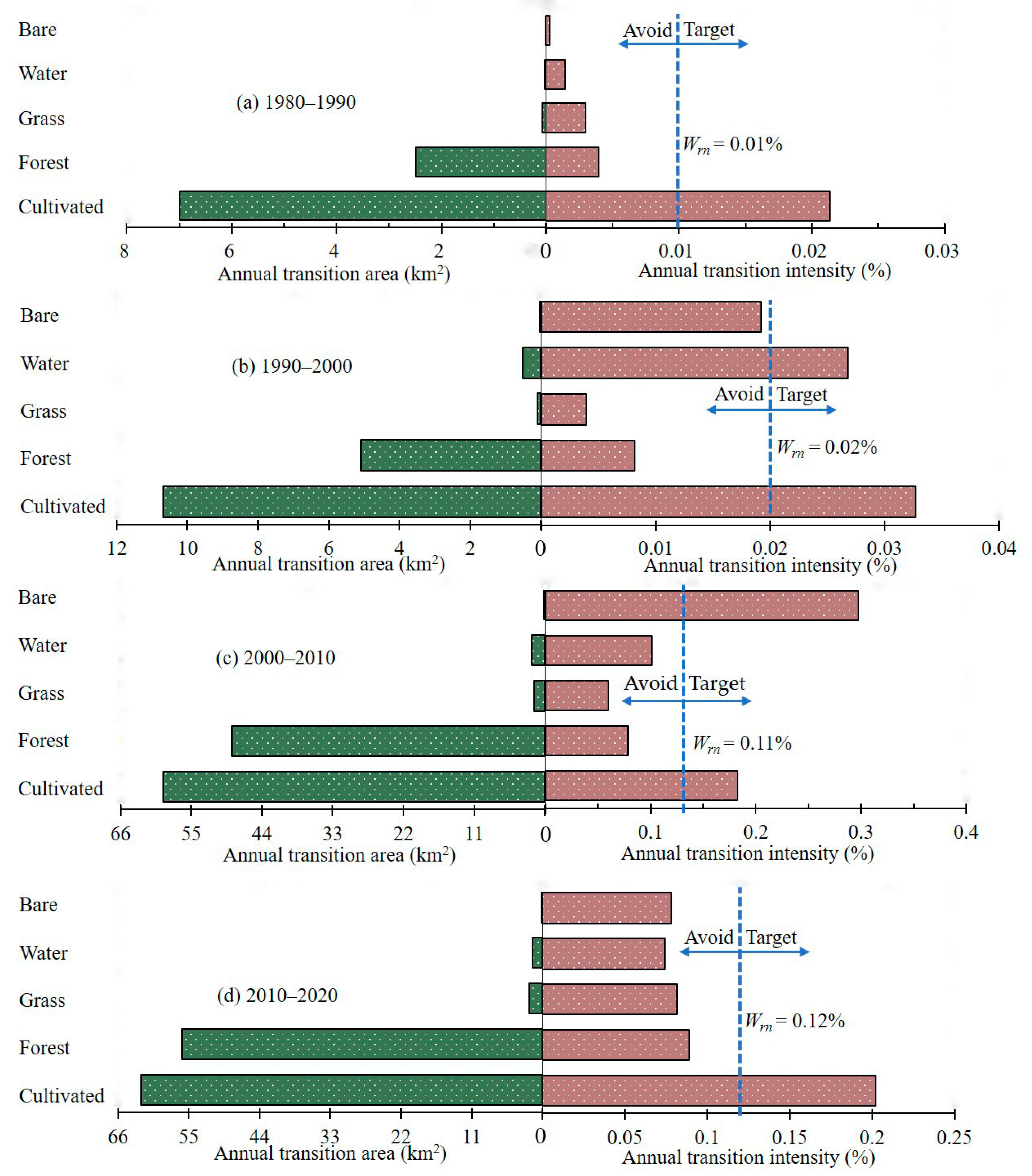
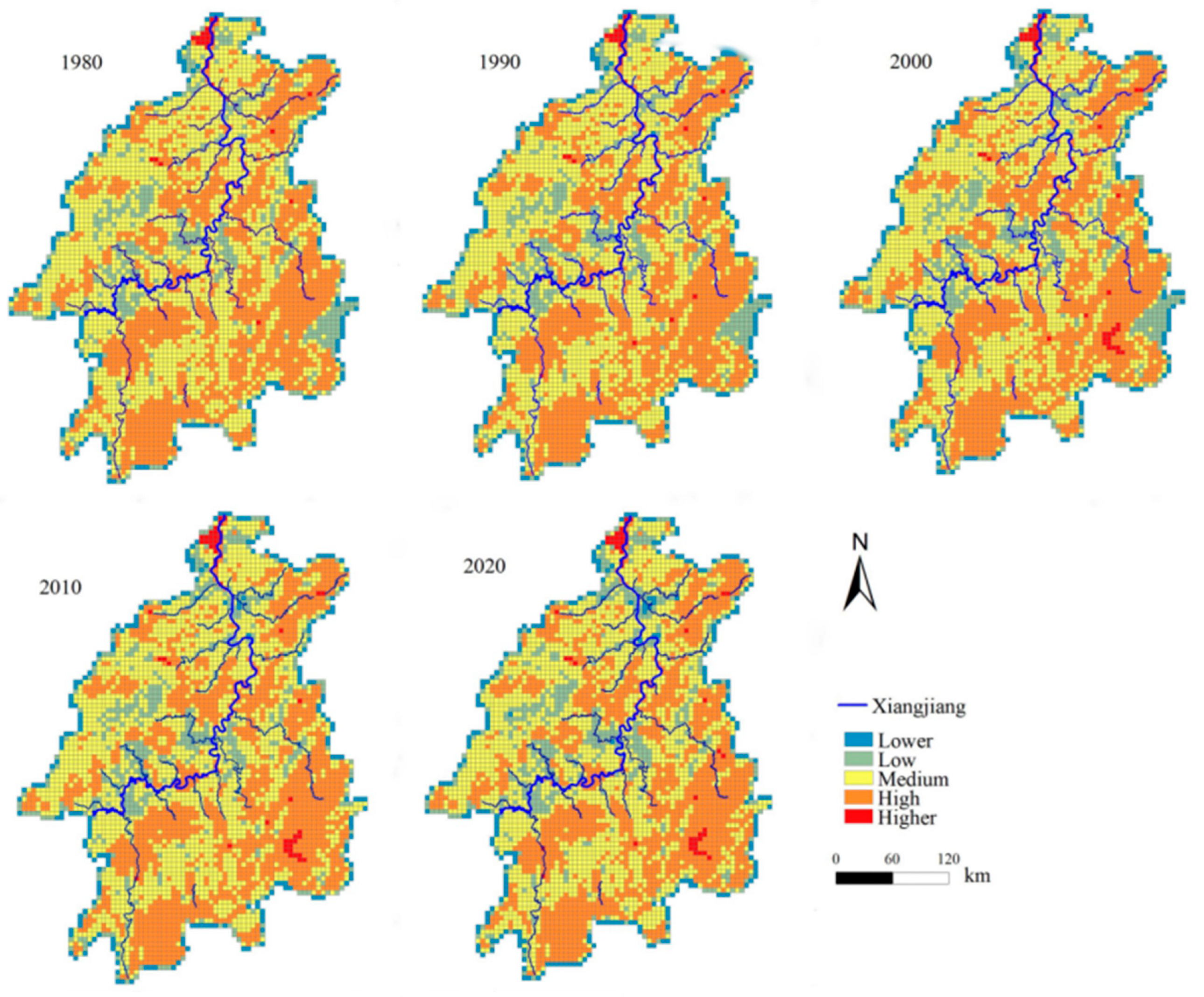
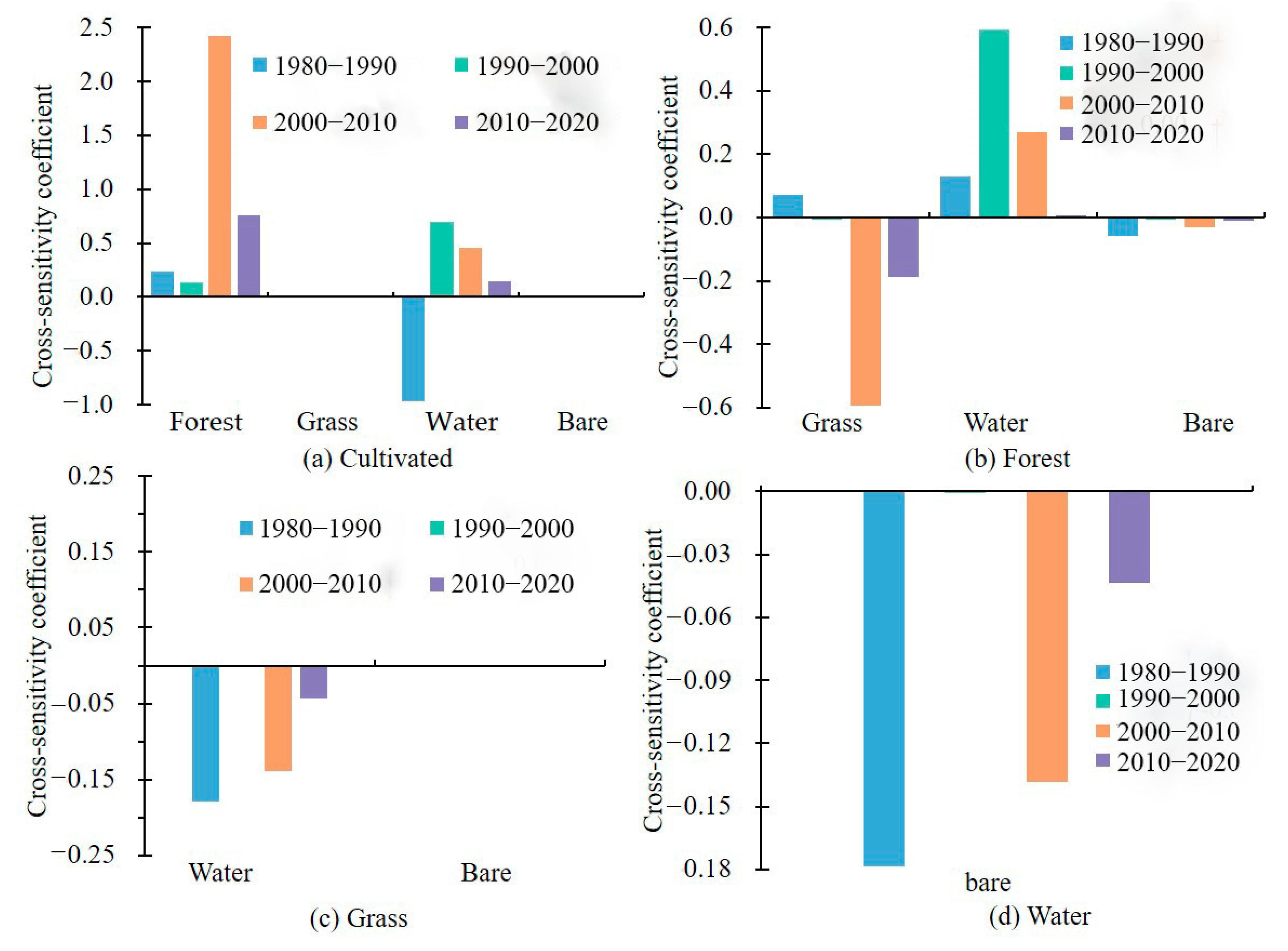
| Symbol | Cultivated |
|---|---|
| T | Number of time points |
| t | Index of the initial time point for a time interval |
| J | Number of categories |
| i | Index for a category |
| j | Index for a category |
| Ctij | Number of pixels that transition from category i to category j during interval [Yt, Yt+1] |
| Ctji | Number of pixels that transition from category j to category i during interval [Yt, Yt+1] |
| dj | Annual difference for category j during interval [Yt, Yt+1] |
| qj | Annual quantity component for category j at interval [Yt, Yt+1] |
| ej | Annual exchange component for category j at interval [Yt, Yt+1] |
| mj | Annual shift component for category j at interval [Yt, Yt+1] |
| Q | Quantity of all categories at the time interval [Yt, Yt+1] |
| E | Exchange of all categories at the time interval [Yt, Yt+1] |
| M | Shift of all categories at the time interval [Yt, Yt+1] |
| D | Total change component of all categories at the time interval [Yt, Yt+1] |
| St | Annual change rate at interval [Yt, Yt+1] |
| U | Uniform change intensity at whole time interval |
| Lti | Intensity of loss in time interval [Yt, Yt+1] for category i |
| Gtj | Intensity of gain in time interval [Yt, Yt+1] for category j |
| Trin | Intensity of transition from category i to a special category n at the interval [Yt, Yt+1] |
| Wrn | Uniform intensity from every category to category n at time [Yt, Yt+1] |
| Ecosystem Service Functions | Cultivated | Forest | Grass | Water | Bare | |
|---|---|---|---|---|---|---|
| Supply services | Food production | 2724.57 | 272.46 | 817.37 | 272.46 | 27.25 |
| Raw material production | 272.46 | 7083.88 | 136.23 | 27.25 | 0 | |
| Regulate service | Gas regulation | 1362.29 | 9536.00 | 2179.66 | 0 | 0 |
| Climate regulation | 2424.87 | 7356.34 | 2452.11 | 1253.30 | 0 | |
| Hydrological regulation | 1634.74 | 8718.62 | 2179.66 | 55,526.74 | 81.74 | |
| Waste disposal | 4468.29 | 3569.19 | 3569.19 | 49,532.68 | 27.25 | |
| Support services | Soil conservation | 3977.87 | 10,625.82 | 5312.91 | 27.25 | 54.49 |
| Maintaining biodiversity | 1934.44 | 8882.10 | 2969.78 | 6784.18 | 926.35 | |
| Cultural services | Aesthetic Landscape | 27.25 | 3487.45 | 108.98 | 12,069.85 | 27.25 |
| Land Use Type | Value (108/CNY) | ||||
|---|---|---|---|---|---|
| 1980 | 1990 | 2000 | 2010 | 2020 | |
| Cultivated | 617.93 | 615.20 | 610.90 | 581.62 | 570.40 |
| Forest | 3712.84 | 3712.32 | 3705.22 | 3745.96 | 3723.19 |
| Grass | 56.33 | 56.37 | 56.28 | 50.59 | 49.27 |
| Water | 229.11 | 237.77 | 261.48 | 271.15 | 276.23 |
| Bare land | 0.10 | 0.09 | 0.09 | 0.13 | 0.11 |
| Total | 4616.31 | 4621.75 | 4633.96 | 4649.46 | 4619.21 |
| Ecosystem Service Functions | Value (108/CNY) | ||||
|---|---|---|---|---|---|
| 1980 | 1990 | 2000 | 2010 | 2020 | |
| Food production | 109.29 | 108.91 | 108.31 | 102.38 | 102.23 |
| Raw material production | 272.46 | 7083.88 | 136.23 | 27.25 | 451.69 |
| Gas regulation | 645.67 | 645.40 | 643.94 | 647.72 | 643.11 |
| Climate regulation | 547.67 | 547.35 | 546.14 | 546.80 | 542.43 |
| Hydrological regulation | 705.12 | 708.65 | 717.73 | 724.69 | 722.48 |
| Waste disposal | 469.92 | 472.67 | 480.57 | 478.81 | 476.55 |
| Maintaining soil | 808.56 | 807.91 | 805.72 | 805.20 | 798.41 |
| Maintain biodiversity | 639.60 | 639.81 | 639.73 | 641.03 | 636.55 |
| Aesthetic Landscape | 240.78 | 241.58 | 243.44 | 246.65 | 245.78 |
Disclaimer/Publisher’s Note: The statements, opinions and data contained in all publications are solely those of the individual author(s) and contributor(s) and not of MDPI and/or the editor(s). MDPI and/or the editor(s) disclaim responsibility for any injury to people or property resulting from any ideas, methods, instructions or products referred to in the content. |
© 2023 by the authors. Licensee MDPI, Basel, Switzerland. This article is an open access article distributed under the terms and conditions of the Creative Commons Attribution (CC BY) license (https://creativecommons.org/licenses/by/4.0/).
Share and Cite
Zhou, Z.; Quan, B.; Deng, Z. Effects of Land Use Changes on Ecosystem Service Value in Xiangjiang River Basin, China. Sustainability 2023, 15, 2492. https://doi.org/10.3390/su15032492
Zhou Z, Quan B, Deng Z. Effects of Land Use Changes on Ecosystem Service Value in Xiangjiang River Basin, China. Sustainability. 2023; 15(3):2492. https://doi.org/10.3390/su15032492
Chicago/Turabian StyleZhou, Ze, Bin Quan, and Zhiwei Deng. 2023. "Effects of Land Use Changes on Ecosystem Service Value in Xiangjiang River Basin, China" Sustainability 15, no. 3: 2492. https://doi.org/10.3390/su15032492
APA StyleZhou, Z., Quan, B., & Deng, Z. (2023). Effects of Land Use Changes on Ecosystem Service Value in Xiangjiang River Basin, China. Sustainability, 15(3), 2492. https://doi.org/10.3390/su15032492







